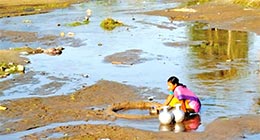Ming-Mang (Assam-Arunachal Border): The entire area looks picturesque with blue hills on the northern horizon sloping towards the plains full with different streams and brooks flowing through paddy fields of villages. But this seemingly beautiful landscape dotted with huts and chang ghars of villages on the inter-State border areas of Assam and Arunachal Pradesh in Lakhimpur and Dhemaji districts has a dark underbelly of deprivation and inaccessibility. There is hardly any water fit for drinking.

The entire Ming Mang area under Bordoloni Development Block of Dhemaji district in Assam bordering Siang district of the neighbouring Arunachal State has the same problem – no source of safe and pure drinking water. A few kilometres from Gogamukh, the commercial hub on the post-Bogibeel connectivity route lie 24 villages under Ming Mang Gaon Panchayat of Dhemaji district of the Mising tribal community. These two dozen ST villages of Bogipung, Bogolijan, Chagun Adi, Champak Suiu, Sengeli Suti, No. 2 Sengeli Suti, Dirpai Shantipur, Dirpai Adi, Ghasi pothar, Harioni, Himedai, Zengraigaon, Zengrai Sathgharia, Kailashpur, Kathalguri Miri, Kayam Borpothar, Madanpur, Ming Mang, Ming Mang Badati, No. 2 Pahar Pothar, Paharpur, Parbatipur, Pichala and Uriumguri were supposed to be covered by an ambitious inter-State road project from Gogamukh to Daporizo in Arunachal Pradesh by the North East Council.
However, after the construction of the road for some distances with two iron bridges, the project remained suspended for reasons unknown to the local people here leaving them unconnected.
But though the construction of new roads to Ming Mang has now transformed the lives of these two dozen villagers with better movement of goods and services for economic growth, this fundamental problem of drinking water shortage is acute.
The district receives heavy rainfall from the southwest monsoon from May to July with an average annual rainfall of 3435 mm. Yet the lack of basic facilities like ground water sources for drinking water is depriving a population of more than 20,000 in this area from this most fundamental need.
According to the Central Ground Water Board (CGWB), North Eastern Region, Ministry of Water Resources, Guwahati, the flow of ground water is from north to south in Dhemaji district in which the pre-monsoon water level varies from 0.01 to 9.40 mbgl and post-monsoon water level varies from 0.56 to 8.26 mgbl. Depth of water level during pre-monsoon is higher than post-monsoon. This may be the reason for which the Ming Mang area, on the foothills of the sub-Himalayan range on the northern side of the Brahmaputra is having shortage of ground water sources during this time.
Another important aspect of drinking water problem in this region is the concentration of arsenic (As) and fluoride (F) in ground water. According to CGWB, the chemical quality of ground water in Dhemaji district showed high concentration of some harmful elements. Iron (Fe) and arsenic (As) content in the ground water of the district has been observed high which is greater than permissible limit set by the Bureau of Indian Standards IS 10500-1991’s (Desirable : 0.3 mg/l , Permissible : 1.0 mg/l) and WHO.
Research conducted by AK Singh in 2004 reported maximum arsenic contamination in ground-water of Dhemaji’s Sissiborgoan and Dhemaji blocks, and in Lakhimpur’s Bogeenadi and North Lakhimpur block. A CGWB special study report of 2003-04 reveals that the fluoride concentration rises (>1.5 ppm) in the pre-monsoon period in ground water of Dhemaji district and that makes the water undesirable for drinking.
People, mostly women are seen collecting water for drinking and cooking purposes from perennial streams and rivers flowing from the hills of Arunachal Pradesh and passing through Ming Mang. Small rivers like Naharjaan, Chengeleejaan and Bogoleejaan, mostly in dry condition, are seen dotted with women from the villages collecting water for drinking as well as washing and bathing. The condition of the water of these rivers for drinking purposes has also not been studied so far by any agency. However, apparently they look unhealthy for drinking.
The district Public Health and Engineering department has plans for the extraction of ground water in a planned manner from the existing hydro-geological set up in Dhemaji since there is huge ground water resources. This indicates that there is much scope for ground water in the future and it can also be extracted by means of tube wells or filter point wells. But for the people of Ming Mang, these dreams are far to materialize.
On September 16, 2018 the Dhemaji and Ghilamora divisions of Public Health Engineering & Water Supply (PHE &WS) launched eight piped water supply schemes in Dhemaji district under National Drinking Water Supply Programme to provide safe drinking water to rural people. The department has spent around Rs 9.5 crore for the implementation of the schemes setting a target to cover 8,600 people. However, the schemes are yet to cover people living in the border areas of Ming Mang, Mohori Camp and areas close to Gerukamukh.
based on local media reports

